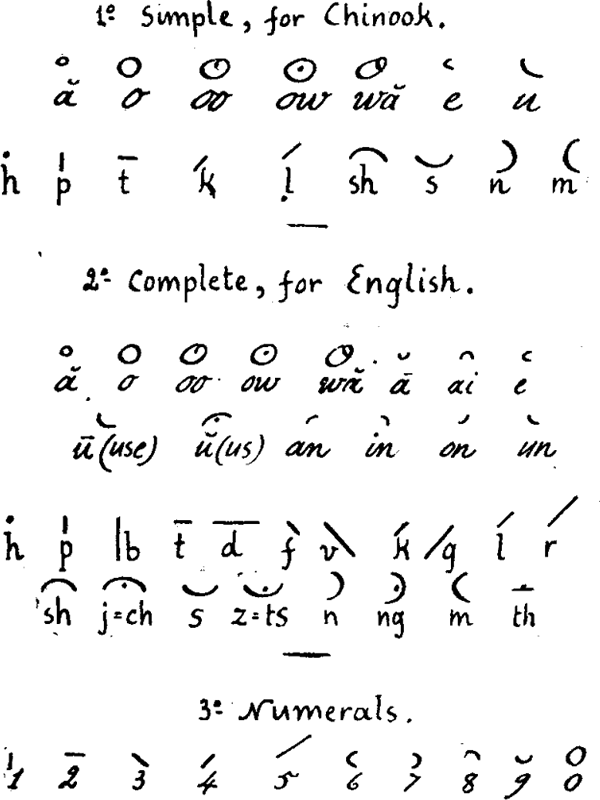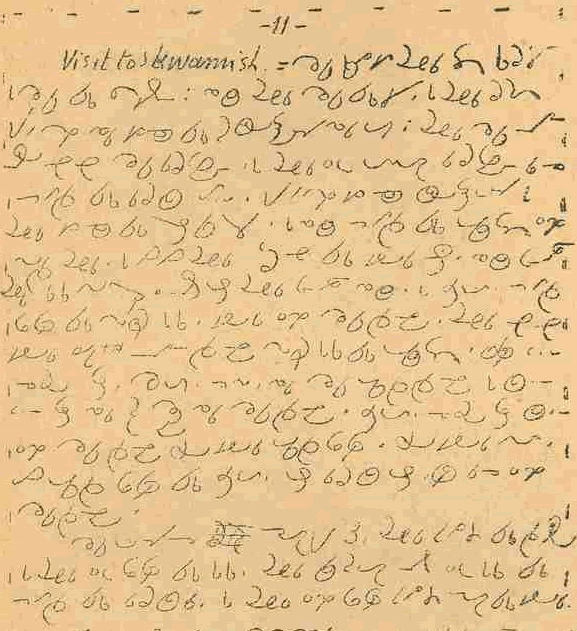Chinook Jargon developed as a pidgin used in trading interactions between the people of the Pacific Northwest in the USA and Canada during the 19th century. It first emerged along the lower Columbia River, and then spread to other parts of what are now Oregon and Washington states, and to British Columbia, Alaska and Yukon Territory.
Much of the vocabulary of Chinook Jargon comes from the languages of the Chinook people. Chinook Jargon also includes words from English and French, as well as from a variety of local indigenous languge. It has a small vocabularly, and a simple grammar, so is easy to learn.
The peak Chinook Jargon usage was between about 1858 and 1900 with an estimated 100,000 speakers. After this it declined, though continued to be used in some business sectors into the 20th century, particularly by members of the Arctic Club in Seattle until about 1939.
Chinuk pipa is a script for Chinook Jargon based on Duployan Shorthand/Stenography, which was first created in 1860 by Emile Duployé as a way to write French quickly. It was also adapted for writing English, German, Spanish and Romanian. Father Jean-Marie Raphaël Le Jeune came to British Columbia as a missionary in about 1879 and realised that the Latin alphabet was not ideal for writing the Chinook languages decided to adapt Duployan Shorthand instead. He published a newspaper, Kamloops Wawa, in Chinook Jargon written in his adapted version of the shorthand in the 1890s, and hundreds of speakers of Chinook Jargon learnt to read and write using this script. It was also used to publish a number of religious and classical works, and to write diaries.
Duployan Shorthand was also adapted by Denis-Romulus Perrault, a stenographer from Montreal, to write a number of other indigenous languages in Quebec and Newfoundland, and is still used to write the Okanagan, Lillooet, Shushwap and North Thompson languages in British Columbia.

Source: http://www.evertype.com/standards/iso10646/pdf/chinook-and-shorthand.pdf

Source: http://chinookjargon.com/2013/12/05/visit-to-skwamish-a-cj-text/ - includes transliteration and translation
Konoway tillicums klatawa kunamokst klaska mamook okoke huloima chee illahie.
Everyone was thrown together to make this strange new country.
Source: from a poem by Terry Glavin and Charles Lillard entitled "Rain Language". For more details, see: https://thetyee.ca/Life/2006/01/10/StillSpeakChinook/. You can see more of the poem at: http://illahie.blogspot.co.uk/2014/03/rain-language-part-1-poem-by-terry.html
Information about Chinook Jargon | Numbers
Information about the Chinook Jargon language and the Chinuk pipa script
http://chinookjargon.com
http://en.wikipedia.org/wiki/Chinook_Jargon
http://dspace.library.uvic.ca:8080/handle/1828/3840
http://www.evertype.com/standards/iso10646/pdf/chinook-and-shorthand.pdf
http://std.dkuug.dk/JTC1/SC2/WG2/docs/n3895.pdf
Chinook Jargon Phrasebook
http://www.cayoosh.net/hiyu/kamloops.html
Chinook Texts
http://www.sacred-texts.com/nam/nw/chinook/index.htm
Information about Duployan Shorthand
http://scriptsource.org/cms/scripts/page.php?item_id=script_detail&key=Dupl
Betawi, Bislama, Cape Verdean Creole, Chavacano, Chinook Jargon, Dominican Creole French, Fanagalo, French Guianese Creole, Guadeloupean Creole, Guinea-Bissau Creole, Haitian Creole, Jamaican, Kituba, Manado Malay, Mauritian Creole, Nagamese, Ndyuka, Norfuk, Nubi, Palenquero, Papiamento, Pijin, Réunion Creole, Sango, Saramaccan, Seychelles Creole, Sierra Leonean Creole, Singlish, Sranan, Saint Lucian Creole, Tok Pisin, Torres-Strait Creole
A-chik Tokbirim, Adinkra, ADLaM, Armenian, Avestan, Avoiuli, Bactrian, Bassa (Vah), Beitha Kukju, Beria (Zaghawa), Borama / Gadabuursi, Carian, Carpathian Basin Rovas, Chinuk pipa, Chisoi, Coorgi-Cox, Coptic, Cyrillic, Dalecarlian runes, Elbasan, Etruscan, Faliscan, Fox, Galik, Georgian (Asomtavruli), Georgian (Nuskhuri), Georgian (Mkhedruli), Glagolitic, Global Alphabet, Gothic, Greek, Hurûf-ı munfasıla, Irish (Uncial), Kaddare, Kayah Li, Khatt-i-Badíʼ, Khazarian Rovas, Koch, Korean, Latin, Lepontic, Luo Lakeside Script, Lycian, Lydian, Manchu, Mandaic, Mandombe, Marsiliana, Medefaidrin, Messapic, Mongolian, Mro, Mundari Bani, Nag Chiki, Naasioi Otomaung, N'Ko, North Picene, Novo Tupi, Nyiakeng Puachue Hmong, Odùduwà, Ogham, Old Church Slavonic, Oirat Clear Script, Ol Chiki (Ol Cemet' / Santali), Old Italic, Old Nubian, Old Permic, Ol Onal, Orkhon, Osage, Oscan, Osmanya (Somali), Pau Cin Hau, Phrygian, Pollard script, Runic, Székely-Hungarian Rovás (Hungarian Runes), South Picene, Sutton SignWriting, Sunuwar, Tai Viet, Tangsa, Todhri, Toto, Umbrian, (Old) Uyghur, Wancho, Yezidi, Zoulai
Page last modified: 15.03.23
[top]
You can support this site by Buying Me A Coffee, and if you like what you see on this page, you can use the buttons below to share it with people you know.

If you like this site and find it useful, you can support it by making a donation via PayPal or Patreon, or by contributing in other ways. Omniglot is how I make my living.
Note: all links on this site to Amazon.com, Amazon.co.uk
and Amazon.fr
are affiliate links. This means I earn a commission if you click on any of them and buy something. So by clicking on these links you can help to support this site.
[top]